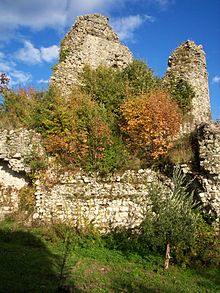1688 Sannio earthquake
| Local date | June 5, 1688 |
|---|---|
| Local time | Late afternoon |
| Magnitude | 7.0 Mw[1] |
| Epicentre | 41°16′N 14°35′E / 41.267°N 14.583°E |
| Areas affected | Campania |
| Max. intensity | MMI XI (Extreme) |
| Casualties | est. 10,000 dead[1] |
The 1688 Sannio earthquake occurred in the late afternoon of June 5 in the
Earthquake
The earthquake occurred in the southern and central part of the Apennines, an earthquake-prone area where several large
The earthquake was preceded by lighter earthquakes starting in February 1688 and by a series of
Damage

Three towns were completely destroyed by the earthquake: Cerreto Sannita, Guardia Sanframondi, and Civitella Licinio, a frazione of Cusano Mutri. In 20 more villages and towns near the epicentre, destruction was almost total. In an area of 50,000 square kilometres (19,000 sq mi), about 120 settlements took extensive damage, while about 40–50 other towns were damaged only slightly.[1][5]
Benevento was hit harshly by the earthquake, with over 80% of the buildings being significantly damaged or destroyed, including the
Casualties
The exact number of deaths resulting from the earthquake is unknown, but it is estimated to total approximately 10,000. Cerreto Sannita, the hardest-hit town, lost half its inhabitants, 4,000 out of 8,000. In Civitella Licinio, which was completely destroyed, the only survivors were those who were working in the fields when the earthquake hit. In Guardia Sanframondi there were more than 1,000 victims. In Benevento 1,367 people died out of a population of 7,500; the number of deaths was lower because many citizens were working in the countryside at the time. Hundreds of people died in San Lorenzello, due to a landslide. Several deaths were recorded also in Naples, Avellino and other towns.[1][5][9][place missing]
Effects
Environmental effects
The earthquake caused several landslides originating from the Matese and other mountainsides, among which a large landslide that devastated the town of San Lorenzello.[10] The courses of the Sabato and the Volturno rivers was altered. In the mountains of the Sannio, large clefts opened, new springs were formed and preexistent springs became muddy.[1]
Societal effects
The earthquake had a strong impact on the economy and the social fabric of the affected area, which at the time belonged to the Kingdom of Naples, except for Benevento, which was an exclave of the Papal States. The inhabitants of the area abandoned the destroyed and damaged buildings, and lived in makeshift shelters. Furthermore, buildings devoted to food production like mills were also destroyed, affecting the food supply. The two governments involved granted tax relief to the people of the area and put forth other measures to mitigate the societal effects of the earthquake.[1]

In Naples, there were episodes of looting and public security issues; the inmates of damaged prisons also escaped or were released. Three weeks after the earthquake governmental and economic activities had not restarted yet. In Benevento, the financial help provided by the Papal States was insufficient, and was mostly used to rebuild public and religious institutions.[1]
Aftermath
In Benevento reconstruction was slow, and hindered by contrasts between the citizens and the Papal authorities. Another strong earthquake hit the town 14 years later, in 1702, further slowing down the efforts to rebuild the town.
Cerreto Sannita was rebuilt under the supervision of the Count Marzio Carafa, feudal lord of the town. The old, destroyed settlement was abandoned and rebuilt nearby at a lower altitude, in a place with safer, more stable soil. Acting under the guidance of engineers and technicians, the new town was made with larger roads, square blocks of houses, buildings with only one or two floors, and other safety measures.[1][14][15]
See also
- Cerreto Sannita
- List of earthquakes in Italy
- List of historical earthquakes
- San Lupo
- History of Cerreto Sannita
References
- ^ INGV. 26 June 2014.
- ^ Samuelson, Kate (24 August 2016). "Why Italy Is So Prone to Earthquakes". Time.
- ^ USGS. "M6.3 – central Italy". United States Geological Survey.
- ^ "INGV – DBMI11 – MAP". emidius.mi.ingv.it. INGV. Retrieved 1 December 2017.
- ^ a b c d "Terremoto 1688 Sannio". www.eventiestremiedisastri.it (in Italian). Centro EEDIS.
- ISBN 978-88-7835-232-2.
- ISBN 978-88-7042-942-8.
- ^ Corcia, Nicola (1843). Storia delle due Sicilie dall'antichità piu remota al 1789 (in Italian). Napoli: Tip. Virgilio.
- ISBN 978-88-8498-119-6.
- ISBN 978-1-4987-8807-6.
- ^ "Analisi. Terremoti, la storia insegna a ricostruire" (in Italian). Avvenire. 27 August 2016.
- ^ "Si cercano persone che abbiano la possibilità di indicare la santità di Francesco Maria Orsini, arcivescovo di Benevento". www.gazzettabenevento.it (in Italian). 23 February 2010.
- ^ Napolitano, Vincenzo (1988). Bucciano da Casale a Comune (in Italian) (1st ed.). Benevento: Amministrazione comunale di Bucciano. p. 37.
- ^ Pescitelli, Renato (2001). Palazzi, Case e famiglie cerretesi del XVIII secolo: la rinascita, l'urbanistica e la società di Cerreto Sannita dopo il sisma del 1688 (in Italian). Telese Terme: Don Bosco.
- ^ "A Cerreto Sannita da 300 anni ci sono case antisismiche (ma gli studiosi sono divisi)". corrieredelmezzogiorno.it (in Italian). Corriere della Sera. 26 August 2016.
External links
- Page on the 1688 Sannio earthquake from the CFTI5 Catalogue of Strong Earthquakes in Italy (461 BC – 1997) and Mediterranean Area (760 B.C. – 1500) Guidoboni E., Ferrari G., Mariotti D., Comastri A., Tarabusi G., Sgattoni G., Valensise G. (2018) (in Italian)

